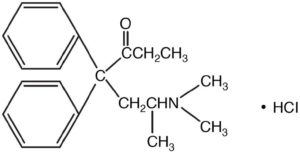How is methadone used to treat drug abuse?
Methadone is FDA-approved medication-assisted treatment for Opioid Use Disorder (OUD). It is also used to treat other forms of drug abuse including heroin addiction. Patients who have developed opioid tolerance may not respond to conventional analgesic regimens. So, methadone is used to improve their response to analgesic interventions. When used, methadone dosages are altered or combined with other opioids as adjuvant therapies.
Methadone is an antagonist of the N-methyl-d-aspartate (NMDA) receptor and a full agonist of the opioid receptor (MOR). It also has a comparatively longer duration of action and half-life than short-acting and extended-release morphine formulations. This longer duration of action makes methadone a good option for treating addiction since fewer doses are required to maintain analgesia and prevent opioid withdrawal symptoms.
Methadone blocks opioid effects by acting on opioid receptors in the brain, the same receptors that other opioids (e.g., codeine, heroin, hydrocodone, morphine, and oxycodone) stimulate. However, while methadone occupies and activates these opioid receptors, it does not cause a euphoric high at the dosages recommended for drug abuse treatment.
Its pharmacodynamic and pharmacokinetic characteristics reduce withdrawal symptoms and cravings. Thereby allowing patients to function normally and participate in other treatment or recovery support services.
Withdrawal symptoms are developed when opioid use is reduced or stopped. As a full opioid agonist, methadone fully activates and competitively blocks the opioid receptors in the body. These opiate-blocking qualities lessen the effects of other opioids while reducing cravings.
Therefore, in treatment programs, methadone is typically prescribed if a patient meets the following criteria:
- Presence of severe withdrawal symptoms.
- Substance use in very high doses of prescription or illicit opioids.
- Additional support is needed during recovery.
- Difficulty in sticking to a treatment plan.
Methadone dosing is dependent on the therapeutic need.
For pain management, the recommended dose is 2.5 mg orally every eight hours with slight dose increments if needed weekly. This applies to people who haven’t developed any form of opioid tolerance. In individuals with opioid tolerance, 10mg of methadone is given orally.
For opioid disorders, the recommended dose is 30 to 40 mg/day. It is titrated upwards by 10 to 20 mg/week to an optimal of 80 to 150 mg/day. Long-term treatment is optimal if it lasts for at least 14 months.
For opioid withdrawal, dosing is between 10 to 20 mg. This dose is increased by 10mg till withdrawal symptoms subside. After 2 to 3 days, this dose is reduced daily by 10% to 20% as withdrawal symptoms reduce.
